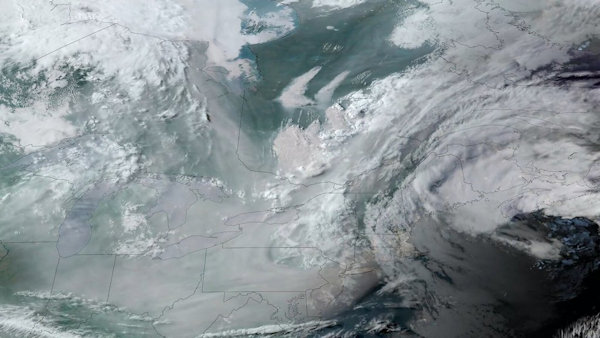SEJournal Online is the digital news magazine of the Society of Environmental Journalists. Learn more about SEJournal Online, including submission, subscription and advertising information.
 |
 |
| Thick smoke from Canadian wildfires, monitored by the GOES-16 satellite, drifts over the United States on June 6, 2023. Image: NOAA (Public Domain). |
Reporter’s Toolbox: ‘Orange’ Is the New Data — for Wildfire Smoke
By Joseph A. Davis
Orange can be an alarming color — not just on the air quality maps but when you look out the window at the sky during a wildfire smoke event.
Environmental journalists should be attuned to that orange as well, in order to track wildfire smoke when it comes to their communities.
Some databases can help with that. AirNow is still the reigning superstar for many. Toolbox has written about it before.
But as wildfire smoke has periodically become one of the biggest North American air quality problems, AirNow has evolved to focus more specifically on wildfire smoke.
Where the data come from
AirNow is a map presentation of data from multiple agencies that allows journalists and the public to envision air pollution in near-real-time. The U.S. Environmental Protection Agency is the lead actor, but other federal and state agencies participate, widening the foundation of basic data.
But as Canadian smoke darkens the skies of the U.S.’s Mountain West, Midwest and East, it may be good to know a bit more about the sources and nature of wildfire smoke data.
In addition to air-quality monitors on the ground, and the reports of firefighting and land management agencies, satellites are a key data source.
One example is the workhorse GOES-16, which not only maps atmospheric phenomena in 16 spectral bands but also records individual lightning strikes. There are other satellites, but this one is parked in geostationary orbit over North America.
The reason why such satellite data is so
useful is that it integrates wildfire smoke
plumes with other weather phenomena.
The reason why such wide-angle satellite data is so useful is that it integrates wildfire smoke plumes with other weather phenomena — such as fronts and atmospheric currents — giving a better illustration of where the smoke is going and where it is expected to go.
This is how we knew the skies of Manhattan and Washington, D.C., were going to turn orange. Orange as in orange: not just the color on the air map.
Some of us rarely see orange air quality alerts (unhealthy for sensitive groups) … turning to red (unhealthy) in worse events. We may have forgotten that the scale goes up to purple (very unhealthy) and maroon (hazardous).
We saw those colors in some places as the Northeast Canadian wildfire smoke drifted down to New York and Washington.
How to use the data smartly
It is worth remembering that, while actual measurements from air monitors are a basis for AirNow, part of producing the readings is atmospheric modeling (hence the predictions). This is why you may find actual breathable pollution to be a bit different than the maps.
Wildfire smoke data is just the start. Journalists need to help audiences by putting it in the context of human health. See our recent TipSheet on smoke and health. Talk to doctors, meteorologists and pollution mavens.
Here are some additional resources for your reporting:
- National Weather Service's local offices: These have their own weather data. Ask about how wildfire smoke will affect your area.
- National Fire Department Registry: Some state and local fire management agencies exist to fight wildfires. A fine example is CAL FIRE, which offers its own smoke information.
- National Interagency Fire Center: This federal multi-agency hub has a lot of good, current info, including fire maps.
- NOAA’s fire and smoke maps: The National Oceanic and Atmospheric Administration operates many of the satellites looking at smoke. It develops its own data products.
- NASA's Fire Information for Resource Management System: The National Aeronautics and Space Administration’s FIRMS maps wildfires worldwide.
- USA TODAY’s fire and smoke maps: This national news publication specializes in graphic weather overviews.
- Google Maps: This commonly used utility has a wildfire map layer. Who knew? That makes it easy to overlay other info, such as demographics.
- MuckRock guide on wildfire smoke data: This journalism nonprofit has a handy guide for working with wildfire data.
- FireSmoke Canada: This project by Canadian agencies and researchers offers data and maps about current smoke conditions in that country, including cool forecast maps.
[Editor’s Note: For more on wildfires, see our Wildfire Issue page and a recent TipSheet on wildfire smoke, plus Toolboxes on air pollution data sources, air quality monitors and tracking respiratory health risks from wildfire smoke, and an earlier TipSheet on the health threats of smoke.]
Joseph A. Davis is a freelance writer/editor in Washington, D.C. who has been writing about the environment since 1976. He writes SEJournal Online's TipSheet, Reporter's Toolbox and Issue Backgrounder, and curates SEJ's weekday news headlines service EJToday and @EJTodayNews. Davis also directs SEJ's Freedom of Information Project and writes the WatchDog opinion column.
* From the weekly news magazine SEJournal Online, Vol. 8, No. 27. Content from each new issue of SEJournal Online is available to the public via the SEJournal Online main page. Subscribe to the e-newsletter here. And see past issues of the SEJournal archived here.












 Advertisement
Advertisement 



